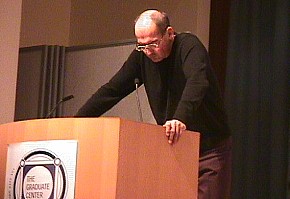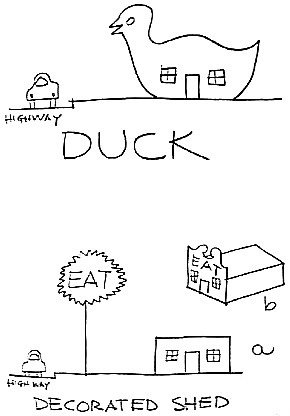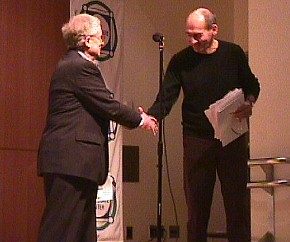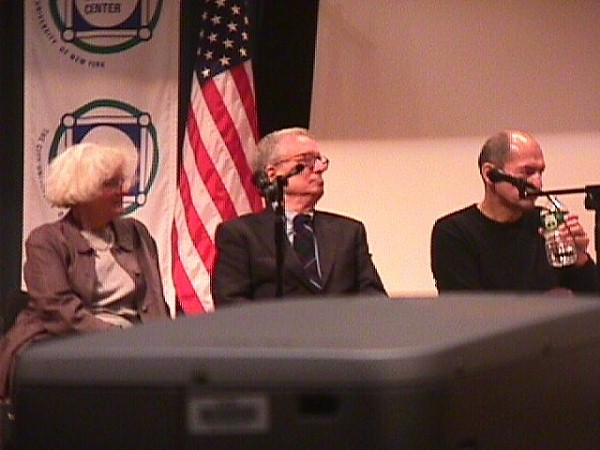The provenance of this transcription is somewhat murky. It came to Quondam's collection via an email attachment from a former VSBA associate, who also received it as an email attachment. In any event, Koolhaas' talk was recorded and transcribed, although the text here appears to be only a first attempt draft.

| |
Rem Koolhaas @ In Your Face
CUNY, New York City
September 29, 2001
It's always a risk to enter a new territory and be part of an organization and an event over which you have had no control. In the introduction, I hear a kind of certain vindictiveness against Modernism which sounds slightly alarming, and I want to emphasize that no matter what comes, the only reason I'm here is my respect for and liking of the Venturis, and we will see later (kind of) how that can be used or abused in this meeting. I want to tell you a number of vignettes and a number of fragmentary interpretations of the activity of the Venturis, and you have to bear with me if it is not entirely smooth, because it is (kind of) fairly recent, but what I hope to do in this (kind of) short presentation is to introduce a series of themes on the Venturis and a reading of the activity of the Venturis that could be maybe helpful in this discussion.
I want to start by a fluke coincidence: the Concorde, the World Trade Center, and Learning from Las Vegas all appeared more or less at the same time, in 1972. You know what happened to the first two, and we don't know what happened to the third. They were all products of a lavish confidence of cultures striving in a single direction, namely forward. [...] that's (kind of) a very important thing [...], and that is where I think the (kind of) placing of the Venturis in a (kind of) anti-Modemist crusade is entirely wrong. (because) I would say that the birthdate of their book and [what is] perhaps the most ambitious achievement in flight and, in certain way, also the most ambitious achievement in terms of architecture [...] is not a coincidence, and it is very important to look at [Learning from Las Vegas] as a form of modernism.
I remember finding Learning from Las Vegas at the Cornell campus store--a massive slab of a book between white socks and underwear. It is still an impressive use of irony, and, for those who don't know the book in its original form, it was kind of a huge book designed in a kind of quasi-Roman, very monumental style. It is an impressive (use of) irony, that a book about architecture is more a theory of [the] future and even its possible disappearance, to have such a monumental and intimidating presence. And I think that introduced, immediately, the aspect of the Venturis--their (kind of) relentless and savage use of irony.
|

| |
And then there's a third chapter. It is mysterious and possibly a result of evaporating public patronage that since Learning from Las Vegas, there have been no more architectural manifestoes. All we now talk about are cities. And the fact that we only talk about cities, and that we only work on manifestoes about cities--whether you talk about Banham's Los Angeles, my own New York mutations, or a whole generation of studies of the urban condition--all of that is (most) blatant proof that our speculative abilities have been surpassed by what exists. And I think that, in a way, the Venturis are interesting. [...they and] Learning from Las Vegas is incredibly interesting because it is [simultaneously] a claim to still be able to invent an architectural manifesto, but, in studying an existing situation, it is also a sign that that ability will soon be over, and perhaps the book itself exhausts that ability for the last time.
[Post] Learning from Las Vegas we had Banham's Los Angeles, Delirious New York, and all these books are connected [...] by their own, for our own, lack of mastery. Somehow it became fashionable after Learning from Las Vegas, (and I think this was certainly not the intentions of Venturi and Scott Brown that it became fashionable), to pride ourselves of our lack of claim to be able to be part of a solution, and that we were gloating [...] increasingly baroque descriptions of inability. But you also have to ask what influence Learning from Las Vegas was on that phenomenon. [...] what the Venturis did then for the first time in an architectural manifesto [was to tell] architects to direct their gaze and the way they were looking outward rather than inward. [...] what is fascinating about Learning from Las Vegas, if you look at it now, is that they were the first architects who did not say how to do anything. [...] Las Vegas was an embodied situation that they decoded to some extent, but they always refrained from (kind of) reading it as a prescriptive condition. [...] I think that certainly Scott Brown's more sociological interest was a kind of driving force in shifting this look of architecture away from architecture, with consequences that cannot be easily understood and that are probably underestimated, to the extent that perhaps the book is the beginning of a crisis of confidence in architecture.
Apart from turning our look outward, the great detonation charge of Learning from Las Vegas was finally the introduction of two sketches--the Duck and the Decorated Shed--that seemingly once and for all reduced all architectural choice to two terminal archetypes, a dilemma that, however disguised its humor and dressed in a rhetoric of populism, was actually pretty malicious[?] and apocalyptic. After Mies's "God is in the details," maybe the discussion of the Shed and the Duck was architecture's equivalent of "God is dead." And I think this is an important statement because (I think) very few people have really understood the darkness of some of the contents of this architectural firm and their kind of thinking.
|
"...the building becomes a diagram of an oversimplified program for living--an abstract theory of either-or. Where simplicity cannot work, simpleness results. Blatant simplification means bland architecture. Less is a bore.
Robert Venturi, Complexity and Contradiction in Architecture (1966), p. 25.
| |
It is their aphorisms more than their forms that have put them in a sequence of precedence in architectures that goes from Vitruvius' "commodity, [firmness] and delight," to Mies's "less is more," to end with a lethal "less is a bore." And I want to again emphasize the darkness of this work because with "less is a bore" became the alibi [... for] the Philistine. It provided the alibi for an American imperialism of history and context from which even (the) thoughtless generic Modernism is a relief, and from which even beyond the obvious, such as Graves, the entire spectrum, from Skidmore to Jerdy to Gehry, is the unintended beneficiary. [...] This is also a statement that is important to address: "less is a bore," no matter how ironic and possibly well-meaning and possibly good the intentions of Bob Venturi when he said this--realize he never said it [sic], just as Mies is rumored to never have said "less is more"-- [...]behind the Guggenheim in Bilbao is "less is a bore" just as it is behind Skidmore's project for Columbus Circle and presumably for whatever takes place at the World Trade Center.
|

| |
Fortunately, there are no architectural tribunals, (yet, but it might be imminent), but it would be a tough assignment to settle whose crimes were bigger: Mies for launching the apotheosis of the Duck, or the Venturis (and I apologize to Denise for saying "Venturis" but it is at this point perhaps excusable and in any event intended clearly to incorporate both of you) for the [?] of the Duck. I actually may have been an unintended witness of the moment when the Venturis' message was taken away from them and taken over by others, where this amazing kind of a divorce between the aphorisms and the kind of written work and the actual architectural work became evident. It was somewhere in the mid-'80s when a number of European and American architectural firms had been summoned to a hotel in Paris to show the Chairman of Disney their projects for hotels in Disney and in EuroDisney. In this moment of inexplicable enlightenment, Disney had chosen a group of European and a group of American architects to work on these hotels, but they had not told each of these groups that they were working, frequently, in competition, so that the cream of the cream of the architectural world came carrying models, and very often found the kind of footprint of the models (kind of) taken by their colleagues.
At that moment (it was an audience that apart from Bob Venturi also included Graves and Stern--Graves at that point already an architect for Disney, and Stem even on the board of Disney) it became clear that a process had taken place that separated the initiator from any possible implementation of his dream, and also it showed the incredible integrity of the initiator. Here were these architects, [...] Stern and Graves, who are two examples of the kind of Disney monumentalism that is still carried forward. And here was Bob Venturi with an incredibly awkward and unspeakably ugly, but, according to the theory, literally correct model, which looked like a New York welfare hotel, and which had a kind of desultory decoration on the top that was either kind of a sunburst or maybe a rainbow.

And it was really clear that that kind of architecture, no matter that Venturi had been the initiator of that movement, representing it in the heart of capitalism at the kind of emerging moment when the market economy was becoming triumphant, that there was simply no hope in hell that it could be realized, and that basically the entire package and the entire thinking was taken away from him, and, ironically, I think that was also the moment that he became more aware that perhaps he was more of a Modernist than even he believed and certainly than his fans believed.
What Venturi and Scott Brown could not anticipate is how Reaganomics and the market economy it launched have influenced their meaning. What is most striking about Leaming from Las Vegas is its relative innocence, but also its position at the beginning of an incredible escalation, the importance of the economy, an incredible withering of the public and an incredible flourishing of the private. [...] Somehow, Reagan and Co. killed the generic. The market has no tolerance for ugly buildings. [...] We all do Ducks now--that is the second bond between schlock and avant garde. The market economy has worked havoc with the Venturis' semantics, and, at the same time, can you blame anyone for influence? And I think that's a kind of very compelling and urgent question, very compelling for anyone who is supposedly successful in architecture currently in the incredible exposure of media culture, the sense of how any idea is debased before it is launched.
It is a cool irony how the amalgamation of a sympathy for America's commercial vernacular, prepared by a hardcore socialist's appreciation of London's East End working class culture, and before that in opening to the truly African, combined with a sometimes pristine probing of the intricacies of European historical precedent, with its push and pull of imposition and deflection, [could result in] a true social, aesthetic, anthropological witch's brew that could no longer be controlled by anyone in the kind of storms of the economy.
Nevertheless I think because of all this phenomena, the current status of the office is enviable. The dialectics of this couple, with the earnestness and stubbornness of the one continues in the frivolity of the other in a kind of reciprocal shielding that has enabled them to engineer a rare mixture of huge influence and relative unpopularity, which, needless to say, today almost corresponds to virtue. I think that it's actually a deeply serious achievement, in this day and age, to find a combination of influence and difficulty that the Venturis have established, and that is perhaps one of the kind of areas by which I am most influenced, and which I think is most exciting.
Maybe the most critical dimension today of their work is the apparent openness of the work that can be so much more moving than the kind of architecture of their contemporaries.
|
| |
  
|






